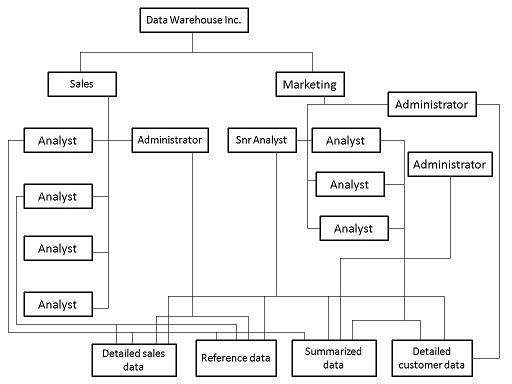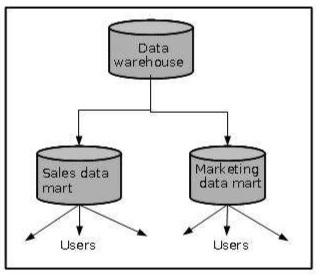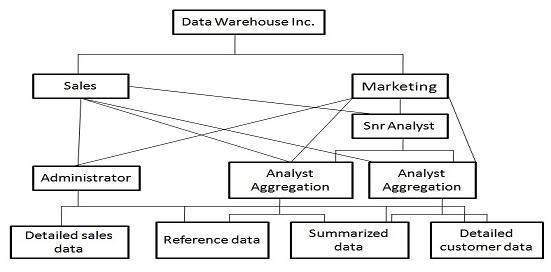
- Data Warehousing Tutorial
- DWH - Home
- DWH - Overview
- DWH - Concepts
- DWH - Terminologies
- DWH - Delivery Process
- DWH - System Processes
- DWH - Architecture
- DWH - OLAP
- DWH - Relational OLAP
- DWH - Multidimensional OLAP
- DWH - Schemas
- DWH - Partitioning Strategy
- DWH - Metadata Concepts
- DWH - Data Marting
- DWH - System Managers
- DWH - Process Managers
- DWH - Security
- DWH - Backup
- DWH - Tuning
- DWH - Testing
- DWH - Future Aspects
- DWH - Interview Questions
- DWH Useful Resources
- DWH - Quick Guide
- DWH - Useful Resources
- DWH - Discussion
Data Warehousing - Security
The objective of a data warehouse is to make large amounts of data easily accessible to the users, hence allowing the users to extract information about the business as a whole. But we know that there could be some security restrictions applied on the data that can be an obstacle for accessing the information. If the analyst has a restricted view of data, then it is impossible to capture a complete picture of the trends within the business.
The data from each analyst can be summarized and passed on to management where the different summaries can be aggregated. As the aggregations of summaries cannot be the same as that of the aggregation as a whole, it is possible to miss some information trends in the data unless someone is analyzing the data as a whole.
Security Requirements
Adding security features affect the performance of the data warehouse, therefore it is important to determine the security requirements as early as possible. It is difficult to add security features after the data warehouse has gone live.
During the design phase of the data warehouse, we should keep in mind what data sources may be added later and what would be the impact of adding those data sources. We should consider the following possibilities during the design phase.
Whether the new data sources will require new security and/or audit restrictions to be implemented?
Whether the new users added who have restricted access to data that is already generally available?
This situation arises when the future users and the data sources are not well known. In such a situation, we need to use the knowledge of business and the objective of data warehouse to know likely requirements.
The following activities get affected by security measures −
- User access
- Data load
- Data movement
- Query generation
User Access
We need to first classify the data and then classify the users on the basis of the data they can access. In other words, the users are classified according to the data they can access.
Data Classification
The following two approaches can be used to classify the data −
Data can be classified according to its sensitivity. Highly-sensitive data is classified as highly restricted and less-sensitive data is classified as less restrictive.
Data can also be classified according to the job function. This restriction allows only specific users to view particular data. Here we restrict the users to view only that part of the data in which they are interested and are responsible for.
There are some issues in the second approach. To understand, let's have an example. Suppose you are building the data warehouse for a bank. Consider that the data being stored in the data warehouse is the transaction data for all the accounts. The question here is, who is allowed to see the transaction data. The solution lies in classifying the data according to the function.
User classification
The following approaches can be used to classify the users −
Users can be classified as per the hierarchy of users in an organization, i.e., users can be classified by departments, sections, groups, and so on.
Users can also be classified according to their role, with people grouped across departments based on their role.
Classification on basis of Department
Let's have an example of a data warehouse where the users are from sales and marketing department. We can have security by top-to-down company view, with access centered on the different departments. But there could be some restrictions on users at different levels. This structure is shown in the following diagram.

But if each department accesses different data, then we should design the security access for each department separately. This can be achieved by departmental data marts. Since these data marts are separated from the data warehouse, we can enforce separate security restrictions on each data mart. This approach is shown in the following figure.

Classification Based on Role
If the data is generally available to all the departments, then it is useful to follow the role access hierarchy. In other words, if the data is generally accessed by all the departments, then apply security restrictions as per the role of the user. The role access hierarchy is shown in the following figure.

Audit Requirements
Auditing is a subset of security, a costly activity. Auditing can cause heavy overheads on the system. To complete an audit in time, we require more hardware and therefore, it is recommended that wherever possible, auditing should be switched off. Audit requirements can be categorized as follows −
- Connections
- Disconnections
- Data access
- Data change
Note − For each of the above-mentioned categories, it is necessary to audit success, failure, or both. From the perspective of security reasons, the auditing of failures are very important. Auditing of failure is important because they can highlight unauthorized or fraudulent access.
Network Requirements
Network security is as important as other securities. We cannot ignore the network security requirement. We need to consider the following issues −
Is it necessary to encrypt data before transferring it to the data warehouse?
Are there restrictions on which network routes the data can take?
These restrictions need to be considered carefully. Following are the points to remember −
The process of encryption and decryption will increase overheads. It would require more processing power and processing time.
The cost of encryption can be high if the system is already a loaded system because the encryption is borne by the source system.
Data Movement
There exist potential security implications while moving the data. Suppose we need to transfer some restricted data as a flat file to be loaded. When the data is loaded into the data warehouse, the following questions are raised −
- Where is the flat file stored?
- Who has access to that disk space?
If we talk about the backup of these flat files, the following questions are raised −
- Do you backup encrypted or decrypted versions?
- Do these backups need to be made to special tapes that are stored separately?
- Who has access to these tapes?
Some other forms of data movement like query result sets also need to be considered. The questions raised while creating the temporary table are as follows −
- Where is that temporary table to be held?
- How do you make such table visible?
We should avoid the accidental flouting of security restrictions. If a user with access to the restricted data can generate accessible temporary tables, data can be visible to non-authorized users. We can overcome this problem by having a separate temporary area for users with access to restricted data.
Documentation
The audit and security requirements need to be properly documented. This will be treated as a part of justification. This document can contain all the information gathered from −
- Data classification
- User classification
- Network requirements
- Data movement and storage requirements
- All auditable actions
Impact of Security on Design
Security affects the application code and the development timescales. Security affects the following area −
- Application development
- Database design
- Testing
Application Development
Security affects the overall application development and it also affects the design of the important components of the data warehouse such as load manager, warehouse manager, and query manager. The load manager may require checking code to filter record and place them in different locations. More transformation rules may also be required to hide certain data. Also there may be requirements of extra metadata to handle any extra objects.
To create and maintain extra views, the warehouse manager may require extra codes to enforce security. Extra checks may have to be coded into the data warehouse to prevent it from being fooled into moving data into a location where it should not be available. The query manager requires the changes to handle any access restrictions. The query manager will need to be aware of all extra views and aggregations.
Database design
The database layout is also affected because when security measures are implemented, there is an increase in the number of views and tables. Adding security increases the size of the database and hence increases the complexity of the database design and management. It will also add complexity to the backup management and recovery plan.
Testing
Testing the data warehouse is a complex and lengthy process. Adding security to the data warehouse also affects the testing time complexity. It affects the testing in the following two ways −
It will increase the time required for integration and system testing.
There is added functionality to be tested which will increase the size of the testing suite.
To Continue Learning Please Login